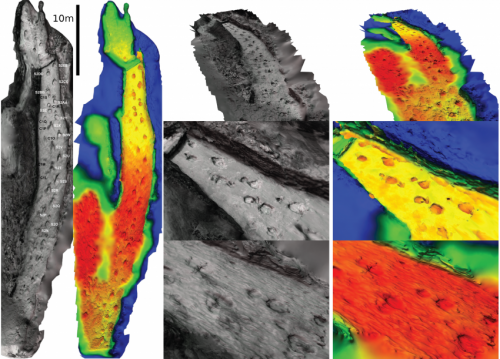Dinosaur chase reconstructed 70 years after excavation

Scientists digitally reconstructed a model of a dinosaur chase using photos of theropod and sauropod footprints excavated 70 years ago, according to results published April 2, 2014, in the open access journal PLOS ONE by Peter Falkingham from Royal Veterinary College, London, and colleagues James Farlow and Karl Bates.
As one of the most famous set of dinosaur tracks in the world, the Paluxy River tracks contain both theropod and sauropod footprints. American paleontologist Roland Bird originally excavated the extensive and well preserved footprints in 1940 in Texas, but post-excavation, paleontologists removed the tracks from their original location, divided them into blocks, and transported them to various locations around the world. Prior to their removal, Bird documented the original site with photos and maps, but since excavation portions of the tracks have been lost. A wealth of information could be gained if we were able to view the tracks in one piece again, so researchers set about making that happen.
To digitally reconstruct the site as it was pre- excavation, scientists scanned 17 photos, developed a model and compared the model to maps drawn by Bird. Despite the variation between the photos and the hand drawn maps, scientists were able to reconstruct and view the entire 45 m long sequence in 3D for the first time since excavation. The 3D digital model helped the authors corroborate the maps drawn by Bird when the tracksite was first described. The authors hope that this study will help others digitally recreate paleontological, geological, or archaeological specimens that have been lost or deteriorated over time, but for which old photographic documentation exists.
Peter Falkingham added, "In recent years technology has advanced to the point where highly accurate 3D models can be produced easily and at very little cost just from digital photos, and this has been revolutionizing many different fields. That we can apply that technology to specimens, or even entire sites, that no longer exist but were recorded photographically is extremely exciting."
More information: Falkingham PL, Bates KT, Farlow JO (2014) Historical Photogrammetry: Bird's Paluxy River Dinosaur Chase Sequence Digitally Reconstructed as It Was prior to Excavation 70 Years Ago. PLoS ONE 9(4): e93247. DOI: 10.1371/journal.pone.0093247
Journal information: PLoS ONE
Provided by Public Library of Science



















